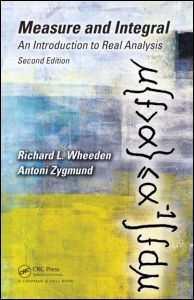Measure and Integral (2nd Ed.) An Introduction to Real Analysis, Second Edition Chapman & Hall/CRC Pure and Applied Mathematics Series
Auteur : Wheeden Richard L.

Now considered a classic text on the topic, Measure and Integral: An Introduction to Real Analysis provides an introduction to real analysis by first developing the theory of measure and integration in the simple setting of Euclidean space, and then presenting a more general treatment based on abstract notions characterized by axioms and with less geometric content.
Published nearly forty years after the first edition, this long-awaited Second Edition also:
- Studies the Fourier transform of functions in the spaces L1, L2, and Lp, 1 < p < 2
- Shows the Hilbert transform to be a bounded operator on L2, as an application of the L2 theory of the Fourier transform in the one-dimensional case
- Covers fractional integration and some topics related to mean oscillation properties of functions, such as the classes of Hölder continuous functions and the space of functions of bounded mean oscillation
- Derives a subrepresentation formula, which in higher dimensions plays a role roughly similar to the one played by the fundamental theorem of calculus in one dimension
- Extends the subrepresentation formula derived for smooth functions to functions with a weak gradient
- Applies the norm estimates derived for fractional integral operators to obtain local and global first-order Poincaré?Sobolev inequalities, including endpoint cases
- Proves the existence of a tangent plane to the graph of a Lipschitz function of several variables
- Includes many new exercises not present in the first edition
This widely used and highly respected text for upper-division undergraduate and first-year graduate students of mathematics, statistics, probability, or engineering is revised for a new generation of students and instructors. The book also serves as a handy reference for professional mathematicians.
Preliminaries. Functions of Bounded Variation and the Riemann–Stieltjes Integral. Lebesgue Measure and Outer Measure. Lebesgue Measurable Functions. The Lebesgue Integral. Repeated Integration. Differentiation. Lp Classes. Approximations of the Identity and Maximal Functions. Abstract Integration. Outer Measure and Measure. A Few Facts from Harmonic Analysis. The Fourier Transform. Fractional Integration. Weak Derivatives and Poincaré–Sobolev Estimates.
Richard L. Wheeden is Distinguished Professor of Mathematics at Rutgers University, New Brunswick, New Jersey, USA. His primary research interests lie in the fields of classical harmonic analysis and partial differential equations, and he is the author or coauthor of more than 100 research articles. After earning his Ph.D. from the University of Chicago, Illinois, USA (1965), he held an instructorship there (1965–1966) and a National Science Foundation (NSF) Postdoctoral Fellowship at the Institute for Advanced Study, Princeton, New Jersey, USA (1966–1967).
Antoni Zygmund was Professor of Mathematics at the University of Chicago, Illinois, USA. He was earlier a professor at Mount Holyoke College, South Hadley, Massachusetts, USA, and the University of Pennsylvania, Philadelphia, USA. His years at the University of Chicago began in 1947, and in 1964, he was appointed Gustavus F. and Ann M. Swift Distinguished Service Professor there. He published extensively in many branches of analysis, including Fourier series, singular integrals, and differential equations. He is the author of the classical treatise Trigonometric Series and a coauthor (with S. Saks) of Analytic Functions. He was elected to the National Academy of Sciences in Washington, District of Columbia, USA (1961), as well as to a number of foreign academies.
Date de parution : 06-2015
15.6x23.4 cm
Thèmes de Measure and Integral :
Mots-clés :
Lebesgue Outer Measure; Riemann Stieltjes Integral; Measure Theory; Hardy Littlewood Maximal Function; Real Analysis; Tonelli’s Theorem; PoincarObolev Estimates; Lim Inf; Weak Derivatives; Type Gδ; Fractional Integration; Disjoint Measurable Sets; Fourier Transform; Riemann Integrable; Harmonic Analysis; Measurable Set; Abstract Integration; Outer Measure; Maximal Functions; Measurable Subset; Identity Approximations; Type Fσ; Borel Set; Lebesgue Integral; Lebesgue Point; Lebesgue Measure; Absolutely Continuous; Egorov’s Theorem; Indefinite Integral; Lebesgue Measurable Functions; Fractional Integral Operators; Fourier Coefficients; Additive Set Function; Measurable Functions; Vice Versa
